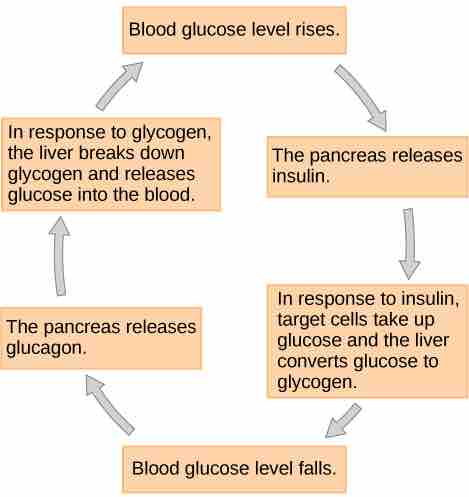Hormonal Regulation of Metabolism
Blood glucose levels vary widely over the course of a day as periods of food consumption alternate with periods of fasting. Insulin and glucagon are the two hormones primarily responsible for maintaining homeostasis of blood glucose levels. Additional regulation is mediated by the thyroid hormones.
Regulation of Blood Glucose Levels: Insulin and Glucagon
Cells of the body require nutrients in order to function. These nutrients are obtained through feeding. In order to manage nutrient intake, storing excess intake, and utilizing reserves when necessary, the body uses hormones to moderate energy stores. Insulin is produced by the beta cells of the pancreas, which are stimulated to release insulin as blood glucose levels rise (for example, after a meal is consumed). Insulin lowers blood glucose levels by enhancing the rate of glucose uptake and utilization by target cells, which use glucose for ATP production. It also stimulates the liver to convert glucose to glycogen, which is then stored by cells for later use. As insulin binds to its target cell via insulin receptors and signal transduction, it triggers the cell to incorporate glucose transport proteins into its membrane. This allows glucose to enter the cell, where it can be used as an energy source. These actions mediated by insulin cause blood glucose concentrations to fall, called a hypoglycemic, or "low sugar" effect, which inhibits further insulin release from beta cells through a negative feedback loop.
Impaired insulin function can lead to a condition called diabetes mellitus, which has many effects on the body . It can be caused by low levels of insulin production by the beta cells of the pancreas, or by reduced sensitivity of tissue cells to insulin. This prevents glucose from being absorbed by cells, causing high levels of blood glucose, or hyperglycemia (high sugar). High blood glucose levels make it difficult for the kidneys to recover all the glucose from nascent urine, resulting in glucose being lost in urine. High glucose levels also result in less water being reabsorbed by the kidneys, causing high amounts of urine to be produced; this may result in dehydration. Over time, high blood glucose levels can cause nerve damage to the eyes and peripheral body tissues, as well as damage to the kidneys and cardiovascular system. Oversecretion of insulin can cause hypoglycemia, low blood glucose levels. This causes insufficient glucose availability to cells, often leading to muscle weakness. It can sometimes cause unconsciousness or death if left untreated.
Diabetes mellitus
Diabetes mellitus can cause a wide range of symptoms, including nausea, vomiting, blurred vision, lethargy, a frequency in urination, and high levels of glucose in the urine.
When blood glucose levels decline below normal levels, for example between meals or when glucose is utilized during exercise, the hormone glucagon is released from the pancreas. Glucagon raises blood glucose levels, eliciting what is called a hyperglycemic effect, by stimulating the breakdown of glycogen to glucose in skeletal muscle cells and liver cells in a process called glycogenolysis. Glucose can then be utilized as energy by muscle cells and released into circulation by the liver cells. Glucagon also stimulates absorption of amino acids from the blood by the liver, which then converts them to glucose. This process of glucose synthesis is called gluconeogenesis. Rising blood glucose levels inhibit further glucagon release by the pancreas via a negative feedback mechanism. In this way, insulin and glucagon work together to maintain homeostatic glucose levels .

The regulation of blood glucose levels by insulin and glucagon
As the levels of glucose in the blood rise, insulin stimulates the cells to take up more glucose and signals the liver to convert the excess glucose to glycogen, a form in which it can be stored for later use. When the levels of glucose in the blood fall, glucagon responds by stimulating the breakdown of glycogen into glucose and signals the production of additional glucose from amino acids.
Regulation of Blood Glucose Levels: Thyroid Hormones
The basal metabolic rate, which is the amount of calories required by the body at rest, is determined by two hormones produced by the thyroid gland: thyroxine, also known as tetraiodothyronine or T4, and triiodothyronine, also known as T3. T3 and T4 release from the thyroid gland are stimulated by thyroid-stimulating hormone (TSH), which is produced by the anterior pituitary. These hormones affect nearly every cell in the body except for the adult brain, uterus, testes, blood cells, and spleen. They are transported across the plasma membrane of target cells where they bind to receptors on the mitochondria, resulting in increased ATP production. In the nucleus, T3and T4activate genes involved in energy production and glucose oxidation. This results in increased rates of metabolism and body heat production. This is known as the hormone's calorigenic effect.
Disorders can arise from both the underproduction and overproduction of thyroid hormones. Hypothyroidism, underproduction of the thyroid hormones, can cause a low metabolic rate leading to weight gain, sensitivity to cold, and reduced mental activity, among other symptoms. In children, hypothyroidism can cause cretinism, which can lead to mental retardation and growth defects. Hyperthyroidism, the overproduction of thyroid hormones, can lead to an increased metabolic rate, which may cause weight loss, excess heat production, sweating, and an increased heart rate.